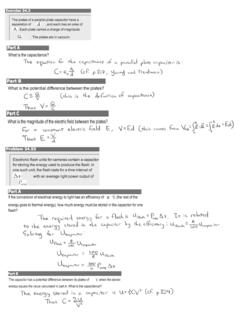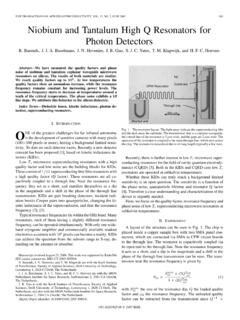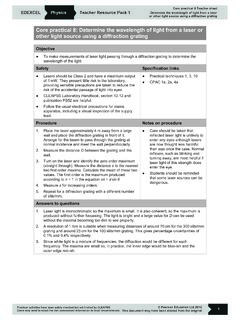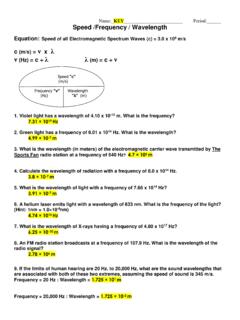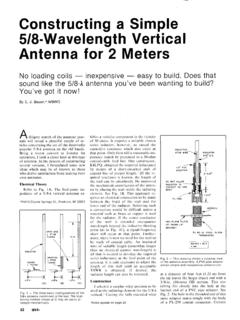Transcription of Physics 102 Lab 8: Measuring wavelengths with a ...
1 Physics 102 Lab 8: Measuring wavelengths with a diffraction grating Dr. Timothy C. Black Spring, 2005. Theoretical Discussion The diffraction of classical waves refers to the phenomenon wherein the waves encounter an obstacle that fragments the wave into components that interfere with one another. Interference simply means that the wavefronts add together to make a new wave which can be significantly different than the original wave. For example, a pair of sine waves having the same amplitude, but being 180 out of phase will sum to zero, since everywhere one is positive, the other is negative by an equal amount. Although the diffraction of light waves ostensibly appears the same as the diffraction of classical waves such as water or sound waves, it is an intrinsically quantum mechanical process.
2 Indeed, while the diffraction pattern of a wave of water requires the simultaneous presence of a macroscopic number of water molecules, (of the order of 1024 ), an optical diffraction pattern can be built up over time by permitting photons to transit the diffracting obstacle one at a time!. This is really pretty amazing if you think about it. It is important to understand the physical processes that are occuring that give rise to the diffraction phenomenon. For the sake of concreteness, we will consider the diffraction of light through a diffraction grating, which is the device that we will be using in today's lab. A diffraction grating consists of a transparent material into which a very large number of uniformly spaced wires have been embedded.
3 One section of such a grating is shown in figure 1. As the light impinges on the grating, the light waves that fall between the wires propagate straight on through. The light that impinges on the wires, however, is absorbed or reflected backward. At certain points in the forward direction the light passing through the spaces (or slits) in between the wires will be in phase, and will constructively interfere. The condition for constructive interference can be understood by studying figure 1: Whenever the difference in pathlength between the light passing through different slits is an integral number of wavelengths of the incident light, the light from each of these slits will be in phase, and the it will form an image at the specified location.
4 Mathematically, the relation is simple: d sin = m . where d is the distance between adjacent slits (which is the same is the distance between adjacent wires)[1], is the angle the re-created image makes with the normal to the grating surface, is the wavelength of the light, and m = 0, 1, 2, .. is an integer. FIG. 1: Geometry determining the conditions for diffraction from a multi-wire grating Diffraction gratings can be used to split light into its constituent wavelengths (colors). In general, it gives better wavelength separation than does a prism, although the output light intensity is usually much smaller. By shining a light beam into a grating whose spacing d is known, and Measuring the angle where the light is imaged, one can measure the wavelength .
5 This is the manner in which the atomic spectra of various elements were first measured. Alternately, one can shine a light of known wavelength on a regular grid of slits, and measure their spacing. You can use this technique to measure the distance between grooves on a CD or the average spacing between the feathers on a bird's wing. Consider figure 2, which shows the set-up for a diffraction grating experiment. If a monochromatic light source shines on the grating, images of the light will appear at a number of angles 1 , 2 , 3 and so on. The value of m is given by the grating equation shown above, so that . m . m = arcsin d FIG. 2: Experimental set-up for Measuring wavelengths with a diffraction grating The image created at m is called the mth order image.
6 The 0th order image is the light that shines straight through. The image created by this interference pattern appears at an angle of = 0 no matter what the wavelength or grating spacing is. Since it gives you no information about the wavelength , it is not particularly interesting. In this lab we will be looking at the first and second order diffraction images of a laser and Measuring its wavelength . We will also measure the visible wavelength range by shining an incandescent light through the grating. The diffraction gratings that you will usetoday have 600 lines/mm, so that the grating spacing is 1. d= mm 600. This number is a distance, and you are going to have to convert it to meters if you want a useful (that is, correct) result.
7 Please remember, once Do not look into the laser! Procedure Part I: Measuring the wavelength of the laser 1. Set up the laser and grating as shown in figure 2. 2. Measure the distance L between the meter stick and the diffraction grating. 3. Turn on the laser and center the meter stick at the 0th order image. 4. Measure the distance s1 between the 1st order images appearing on the left and right sides of the center line. 5. Measure the distance s2 between the 2nd order images appearing on the left and right sides of the center line. It should be clear from simple trigonometric considerations that s s . 1 2. 1 = arctan and 2 = arctan 2L 2L. from which you can extract two independent measurements of the laser wavelength .
8 Part II: Measuring the visible range Replace the laser with the incandescent light. A typical incandenscent lamp emits light all across the visible spectrum. When you shine your light through the diffraction grating, you will see the visible spectrum appearing in the first order. The second order will likely be too dim to see. Using only the first order diffraction images, follow the procedure from the previous section to measure the wavelengths of the longest wavelength light in the spectrum (red) and the shortest wavelength light (violet). Reporting your results: 1. Calculate and report the wavelengths of the laser obtained from your measurements of the first and second order interference maxima, 1 and 2.
9 2. Calculate and report the fractional discrepancy between 1 and 2 . 3. Calculate and report the short wavelength ( b ) and long- wavelength ( r ) limits of your vision obtained from the measurements in part II. [1] This distance is called the grating spacing.

